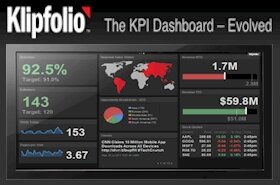There’s no shortage of business intelligence (BI) apps for iOS but most require significant investment in time, training, and costs that few small businesses can afford them. Tools such as MicroStrategy are simply out of reach (financially) for most companies. The data integration requirements alone can be show-stoppers for companies that struggle to maintain basic IT services without an IT department.
GeckoBoard, which is not an iOS app, provides a unique framework for building performance indicator dashboards to help both in-office and mobile workers remain informed. It delivers business intelligence using web standards and a whole lot of HTML5, hence, it is very suitable for in-office and mobile BI applications.
With a well-defined collection of BI widgets, setting up key performance indicators (KPIs) is a snap, almost literally. The challenging part of building useful dashboards falls into the information plumbing category, and therein lies another point worthy of discussion in the context of GeckoBoard – the integration of data into dashboards from iPad apps that have no APIs.
GeckoBoard supports two primary integration pathways; JSON and XML. I prefer the XML route but that just my bias having built many services with MyST, an XML content services platform.
As mentioned above, some (perhaps most) iPad apps don’t have APIs or data interchange features that allow them to stream information into other business applications or processes. However, with a little innovative thinking, it is possible to have data flow from these little islands of information and on to a KPI in GeckoBoard.
Integration Challenges Abound with iOS Apps
Balanced Scorecard, for example, has only one method of sharing its business intelligence data; a PDF report. At first glance, this seems like a dead end. Here’s a snapshot of a PDF report from Balanced Scorecard.

With a little effort we can transform this reporting process from a cul-de-sac into a through-street.
Automated Workflow
Imagine sending the PDF report to a secure DropBox folder that also has a registered folder action that parses the report, generates an XML feed, and deploys it in a manner that GeckoBoard can easily access it. DropBox is one way to achieve this and with some apps, you can upload information directly to DropBox for processing on Windows or Mac computers and eliminate the email step.
Folder actions trigger every time an updated report arrives in the DropBox folder. This makes it possible to fire-and-forget a new report via email and the GeckoBoard dashboard will receive the updated information.

With this approach, it’s possible to stream almost any type of iPad-based information, regardless of the apps that created it, and use it securely across tour organization. GeckoBoard is just one of many ideal solutions that can be used to institutionalize awareness of performance indicators in your company.
In the case of this Balanced Scorecard example, the biggest challenge in building an automated folder action is parsing the PDF report, but luckily, Mac OS X Automator provides built-in handlers for this task. Windows automation systems provide comparable solutions and plugins to achieve this.
Automation is Key
It’s not enough to provide reasonably-priced business intelligence dashboards for small business; it has to be automated. Human capital must be removed, whenever possible, from the integration workflow. But the benefits of striving toward seamless automation pay big dividends by making it possible to focus on results.

There’s much more to explore in GeckoBoard such as the pricing model, the unique and powerful widgets that cut across a wide selection of topics including charts, social media, and RSS. I’ll dive into more about this product in upcoming articles.
With the proliferation of SaaS solutions, pervasive cloud storage services, and simple but effective desktop automation services, there’s typically no integration problem that can’t be solved.




















The best tool for this is Roambi. If you can export the data you want to take on the go we can publish it to your iPad and iPhone. It is as easy as that! Check out our service at http://www.luhringsystems.com
The only way to truly tell what’s what is to try it first hand.
Not so fast Luhring,
While RoamBI is a great data visualization solution for mobile devices and one that I often recommend, if the requirements also include a large (web-enabled) monitor in the conference room, how will RoamBI meet that requirement? The answer is, it can’t. So it’s really important to craft statements of claim as “the best” with business requirements in mind. As such, I disagree with your assertion – the only way to truly get “the best” is to define your requirements, then – and only then – decide which solution is the best implementation strategy.
– bf
This is a great investment for supporting your business.
I am using this great free tool http://WebControlRoom.com which helps small businesses stay on track by providing a 1 page report with data from a number of their favourite sources (Mail Chimp, Analytics, Xero etc).
Norbert,
Thanks for the heds-up on Web Control Room.